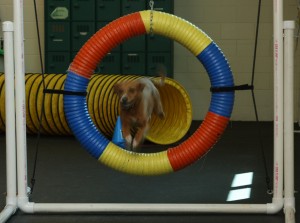
Maslow, baseball, and being safe

When Grace feels safe, she can literally fly! I love this picture, it’s as if she is soaring, both mentally and physically through this obstacle that she has mastered on her own terms, because she has felt safe doing so. Photo by Annie Card.
We watch a lot of baseball in this house. I’m not very good at those split second calls to determine whether the runner reaches the base before the ball. It all happens so fast to me and while I’m still trying to figure it out, I hear an echo in the room between my husband and Don Orsillo proclaiming: “SAFE!” They almost always get the call right.
I go through this with Grace, too. There can be a split second balance between when she feels safe and when she’s not. And I know there have been times when I catch myself discounting her fear—because I know she’ll be fine. When I’m not respectful of her fear, I have in essence, violated her safety zone. For example, when we walk down the street, we occasionally come upon someone new walking and typically the person wants to say hello to Grace. She might back up, hide behind me, or perhaps whine. And I’ve said to her, “It’s ok, Grace. You’ll be fine. This nice person just wants to say hello.” And that does absolutely nothing to make her feel safe. (The better choice is to ask the person to ignore Grace and allow Grace to initiate any interaction on her own terms.)
It was another important lesson I learned at the recent seminar I attended by Suzanne Clothier on fearful dogs—only the dog can define the safe zone. As Suzanne reminded us, safety is the second of five of Maslow’s hierarchy of needs (just above basic needs like food and shelter). Until the needs are met at each level of the pyramid, you cannot move up. If we create an unsafe environment, we are going to remain there, until we feel secure. We can all understand how a child suffering from malnutrition would not be able to focus on school work. Suzanne’s belief, and one that makes sense to me, is that no learning can take place when a dog feels unsafe. But once that dog feels safe, you can teach him nearly anything.
Grace can learn to greet new people – if she can experience that in a safe environment, but never while she’s so terrified that she can’t think straight. You can’t remove fear by telling another person it shouldn’t exist; they have to come to that conclusion.
In organizations, that means that if we want employees to learn new skills, or take bold risks that will improve efficiencies, or bring forward a ground-breaking idea that might initially sound crazy, they need to exist in a safe environment, one that fosters innovation without repercussions.
Are you, as a manager – or a co-worker or a team member – creating safe zones for others? Do you respect the opinion of others and allow them to openly voice an opposing viewpoint? Do you reward ideas even if they don’t work out or do you ridicule or punish for those, even in subtle ways? Are you discounting how someone feels, just because you don’t feel that way?
Only the employee can define the safe zone.
As managers, it’s our responsibility to understand that zone, realizing it’s different with each person, and can change with a new situation. Stay in the game, so you can make that split-second decision whether to call it safe or not.


Grace seems like such a sweetheart.
I have to say that you are absolutely correct! She’s wonderful.
This hierarchy of needs sounds very interesting. Your dog training friends are so wise and experienced. I gather that all creatures not just dogs have very similar levels of need. It makes sense not to discount someones fear. I find this a hard thing to do, when I myself don’t also feel the fear. This is a post full of wisdom.
I completely agree — it is so hard to understand another’s fear when you don’t experience it yourself. I guess it works two-ways; our cats don’t understand why the snake in the basement would bother me when they have so much fun playing with it!